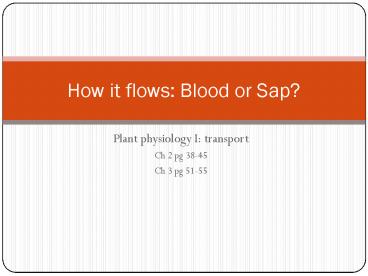Plant physiology I: transport - PowerPoint PPT Presentation
1 / 20
Title:
Plant physiology I: transport
Description:
Water columns in the xylem are pulled up by transpiration in the ... Active pumping of salts into xylem by endodermal cells ... Water diffuses into xylem ... – PowerPoint PPT presentation
Number of Views:410
Avg rating:3.0/5.0
Title: Plant physiology I: transport
1
How it flows Blood or Sap?
- Plant physiology I transport
- Ch 2 pg 38-45
- Ch 3 pg 51-55
2
What is Blood?
- Red
- Hemoglobin
- Protein contains Iron Heme group
- Cells
- RBCs no nucleus
- WBCs- immune system
- Transport
- Oxygen
- Sugars
- Water
- Minerals
- Wastes
3
Animal circulatory system
- Pressure created by mechanical pump (heart)
- 2 sets of tubes
- Arteries (oxygenated blood)
- Veins (deoxygenated blood)
- Blood carries
- Nutrients
- Oxygen and CO2
- Wastes
- Water
4
Plant Tissues Xylem and Phloem
Function Vascular
- Xylem
- Dead large vessels
- Smaller tracheids
- Secondary walls (wood)
- Phloem
- Living sieve tubes
- Companion cells
- Primary walls (paper)
5
Veins also transport fluids in plants
- Vascular cells stack up one on top of the other.
- Form continuous pipes throughout the plant.
- Move water and nutrients from cell to cell.
- Removes waste, and delivers cargo (e.g. food) and
messages.
6
Plant Xylem transport
- Water enters through the root and root hair
- Water passes into the central xylem of the root
- Water moves up through the stem
- Water evaporates inside the leaf
- Water vapor exits through the stomata in the leaf
epidermis
A Typical adult tree Has 200,000 leaves moves
200-1000 gallons of water per day to a height of
100m A 1 acre corn field evaporates 350,000
gallons in 100 day growing period
7
How is it possible to transport fluid with no
energy cost to the plant?
- Consider three chemical /electrical properties of
water - Surface tension
- Capillary action
- Evaporation
8
Figure 1.8a
9
(No Transcript)
10
Cohesion-transpiration theory
Cohesion Water molecules bond to each other and
to cell walls by polar hydrogen bonds.
Tension Water columns in the xylem are pulled up
by transpiration in the evaporating surface
- Evidence
- Tree trunks are fatter when stomata are closed,
narrower when open (transpiring). - Embolisms break water column and prevent water
flow.
11
- Stomata open
- Gasses are exchanged (O2, CO2)
- Water is drawn up into leaves.
- Like sipping through straw
- Many small openings give a transpiration pull,
like an evaporating sponge
- B) Stomata closed
- No gas exchange
- Water is held in columns in the xylem
- Like holding your finger on the end of a straw
12
The endodermis and casparian strip.
- Water diffuses into root hairs and enters
apoplastic pathway (via cell walls) - Active pumping of salts into xylem by endodermal
cells - Salt cannot diffuse out due to casparian strip
- Water diffuses into xylem
- Root pressure is low but may assist water flow
when stomata are closed
13
Control over water flow into the vein
- Casparian strip
- Prevents free flow of water
- Water must pass through the cytoplasm of
endodermal cells - They act as flow regulators for water entry into
the root
14
Xylem transport
- Transport of water and dissolved inorganic salts
- Direction is from root to leaf
- Pulled up by transpiration
- Relies on coordination between root, stem and
leaf - No energy cost
- Controlled by endodermis and guard cells
- Vessels are dead empty pipes
- Xylem is a vein made out of wood
- All wood is Xylem
15
Phloem transport
- SOURCE
- Companion cell loads sugars and solutes into
sieve tube. - Creates high concentration at source.
- Water rushes in from xylem and creates pressure
flow.
- SINK
- Companion cell unloads sugars and solutes from
sieve tube. - Creates low concentration at sink.
16
What is Diffusion?
- Concentrated things tend to dissolve into more
dilute things when not restrained - Solutes (salts, sugars) move from high
concentration to low concentration. - When blocked by a biological membrane, only water
can move freely. - So solvents (water) move from an area of low
solute (salt) concentration to high solute
concentration. - Organisms use diffusion to create pressure.
17
An example of diffusion and movement of water
18
Phloem transport
- Transport of organics and sugars
- Bidirectional - Direction can reverse
- Always from source to sink
- However source and sink status changes
- Daily, seasonally, or during scenescence
- SOURCE
- A site of production or mobilizing storage
- SINK
- A site of consumption or stockpiling storage
19
Comparison of physiology
- Plants move water/nutrients around by
- Transpiration / Evaporation (Xylem)
- Varying sugar concentrations to create pressure
(Phloem) - Linear or bidirectional flow
- Constantly need large volumes of water
(transpiration) - Humans move water/nutrients around by
- Single Low efficiency mechanical pump
- Circulating flow
- Needs only water to replace perspiration/evaporati
on
20
Is Plant sap the same as Blood?
- Plant Sap
- No floating cells
- No O2/CO2 transport
- Phloem carries sucrose, water, minerals, hormones
- Xylem carries water, minerals
- No heart - diffusion
- Two sets of pipes xylem/phloem
- No immune system
- No circulation
- Xylem root hair to stomata
- Phloem source to sink
- Human Blood
- Red blood cells
- Carries O2/CO2, glucose, organics, water,
minerals, hormones - Heart- mechanical pump
- Two sets of pipes artery/vein
- Immune system
- Closed circulation































